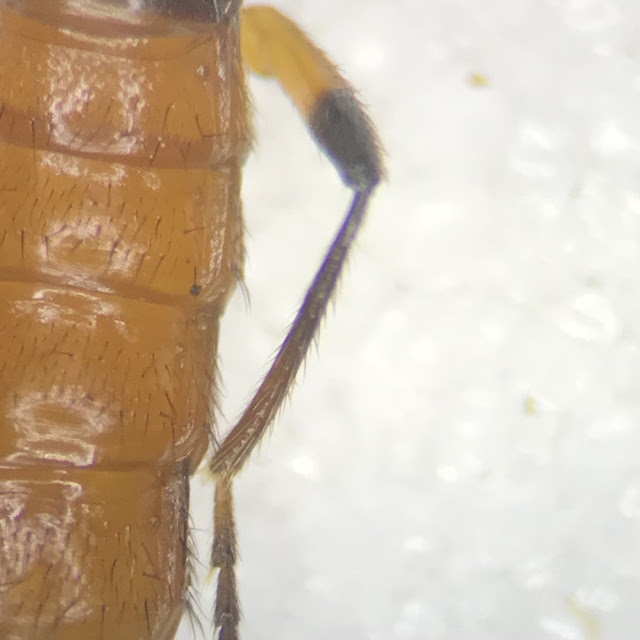Crikey, September. How did that happen? The weather has turned distinctly autumnal too. Blogging has taken a bit of a back seat as other stuff keeps getting in the way.
I just wanted to post some of the new (for me) staphs that I have encountered over the last couple of months from a variety of different places.
To start with are a couple of species that I found in rotting detritus at the edge of Slapton Ley back in mid July.
First up this Paederus species, obvious from it coloring and small peg-like ends to the maxillary palps.
First bit of the key gets you to look at the hind tibia and whether the the dark area extends from the joint to about a third of the way down as opposed to being absent or present as a distinct patch. This individual had the more extensive dark area, in fact the whole tibia is pretty dark, only being ever so slightly lighter in the last third.
The next couplet compares the length and breadth of the elytra compared to the pronotum, either much linger and wider or only just so. Looking at the first image I would say that they are both obviously longer and wider. This takes you to P. fuscipes.
Luckily I had a male so was able to whip out the aedeagus to confirm
The slightly asymmetrical aedeagus tallies and has the parameres differing slightly in length. This seems to be mainly a coastal species mainly in the south west which is why I guess I haven't encountered it before.
Next up was a species of Philonthus.
Counting the pronotal punctures and then comparing the aedeagus had me confused. There were 5 pronotal punctures but none of the diagrams in Lott matched. I then looked at other groups of Philonthus and still nothing seemed to match. I soon got some help on Twitter. The obvious backward pointing apex of the median lobe is diagnostic of Philonthus umbratilis but is only mentioned in the text rather than illustrated. (Note to self to read more of the species descriptions in future). This species is only supposed to have 4 punctures but my specimen seems to have an extra one towards the back back of the pronotum. Looking at the rather good Devon Beetles list online it would seem to be the first record for the county since 1979.
Another day in Devon and another new Philonthus species. This was found in numbers under horse dung and I didn't even need to key it out to put a name to it. Not often I can say that about a staph. The rather lovely P. marginatus, easily identifiable by the pale sides to the pronotum.
A couple more Devon beetles but this time both from the genus Aleochara, both from under rotting seaweed and both looking a little different from the other members of this genus I more regularly encounter.
Firstly there was Aleochara obscurella. As mentioned it didn't stand out as an Aleochara and I failed to run it through the key to genus, so ended up picture matching the aedeagus which was really distinct with what looked like a 'cock and balls' attached, but I can attest that it isn't described that way in the literature!
 |
| Am I just seeing things? |
Once I had worked out the above was a Aleochara, the next one fell much more easily into place and was the more commonly encountered (I think) A. grisea. I had collected a few individuals of each species so as to maximise the chances of getting a male and all the grisea were noticeably smaller than the obscurella.
The next species was a by-product of some tidying. Over the last couple of years Pellitory-of-the-wall seems to have become the default plant of pavement cracks and unattended brickwork in our village. It's everywhere. It really gets into the mortar and so I was clearing it from the front of the house when a tiny staph popped out and made a run for it. Luckily I had a pot to hand. Turned out to be Sunius melanocephalus and the second of this genus to be found in the garden.
Finally, for now. One more species of Philonthus. This one was found last weekend during a family walk in North Norfolk. I had stopped to poke at some cow dung much to everyone's annoyance and grabbed a single Philonthus, fully expecting it to be one of the common ones, but no. I was faced with a asymmetric paramere which nicely matched the images both in the book and online of P. parvicornis. Not too many records on NBN and according to the book - 'habitat uncertain'. Not now it's not. This one was hunting in cow shit!!
Still my favourite beetle family by a country mile. Lucky that's there are so many more to see!













No comments:
Post a Comment